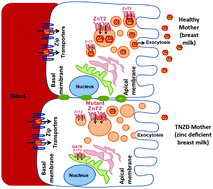当前位置:
X-MOL 学术
›
Metallomics
›
论文详情
Our official English website, www.x-mol.net, welcomes your feedback! (Note: you will need to create a separate account there.)
The role of the zinc transporter SLC30A2/ZnT2 in transient neonatal zinc deficiency
Metallomics ( IF 3.4 ) Pub Date : 2017-06-13 00:00:00 , DOI: 10.1039/c7mt00162b Yarden Golan 1, 2, 3, 4, 5 , Taiho Kambe 6, 7, 8, 9, 10 , Yehuda G. Assaraf 1, 2, 3, 4, 5
Metallomics ( IF 3.4 ) Pub Date : 2017-06-13 00:00:00 , DOI: 10.1039/c7mt00162b Yarden Golan 1, 2, 3, 4, 5 , Taiho Kambe 6, 7, 8, 9, 10 , Yehuda G. Assaraf 1, 2, 3, 4, 5
Affiliation

|
Breast milk is the optimal nutrient mix for infants until the age of 6 months. However, in some cases, due to genetic alterations as well as nutrient deficiencies in nursing mothers, infants may suffer from inadequate levels of micronutrients upon exclusive breastfeeding. In this respect, transient neonatal zinc deficiency (TNZD) is caused by loss-of-function mutations in the zinc transporter SLC30A2/ZnT2 gene, resulting in poor secretion of zinc into the breast milk. Consequently, infants exclusively breastfed with zinc-deficient breast milk develop severe zinc deficiency. The main initial symptoms of zinc deficiency are dermatitis, diarrhea, alopecia, and loss of appetite. Importantly, zinc supplementation of these zinc-deficient infants effectively and rapidly resolves these TNZD symptoms. In the current review, we present the major steps towards the identification of the molecular mechanisms underlying TNZD and propose novel approaches that could be implemented in order to achieve an early diagnosis of TNZD towards the prevention of TNZD morbidity. We also discuss the importance of assessing the prevalence of TNZD in the general population, while taking into consideration its autosomal dominant inheritance that was recently established, also supported by a large number of SLC30A2/ZnT2 variants recently identified in American lactating mothers. These findings indicating that TNZD is more frequent than initially thought, along with the increasing number of TNZD cases that were recently reported worldwide, prompted us here to highlight the importance of early diagnosis of SLC30A2/ZnT2 variants in order to supplement zinc-deficient infants in real-time, thus preventing TNZD morbidity and enhancing newborn health. This early genetic diagnosis of zinc deficiency could possibly prove to be a useful platform for the identification of other micronutrient deficiencies, which could be readily resolved by proper real-time supplementation of the infant's diet.
中文翻译:

锌转运蛋白SLC30A2 / ZnT2在新生儿短暂锌缺乏中的作用
母乳是直到6个月大的婴儿的最佳营养混合物。但是,在某些情况下,由于遗传改变以及哺乳母亲的营养缺乏,婴儿在纯母乳喂养后可能会遭受微量营养素水平不足的困扰。在这方面,暂时性新生儿锌缺乏症(TNZD)是由锌转运蛋白SLC30A2 / ZnT2中的功能丧失突变引起的基因导致母乳中锌的分泌不良。因此,仅用锌缺乏母乳进行母乳喂养的婴儿会出现严重的锌缺乏症。锌缺乏的主要初始症状是皮炎,腹泻,脱发和食欲不振。重要的是,对这些缺锌婴儿的补锌可以有效,迅速地消除这些TNZD症状。在当前的审查中,我们介绍了识别TNZD潜在分子机制的主要步骤,并提出了可以实施的新方法,以实现对TNZD的早期诊断以预防TNZD发病。我们还讨论了评估TNZD在一般人群中的患病率的重要性,同时考虑到最近建立的TNZD常染色体显性遗传,最近在美国哺乳期母亲中发现了SLC30A2 / ZnT2变体。这些发现表明,TNZD的发病率比最初想像的要高,加上最近在世界范围内报道的TNZD病例数的增加,促使我们在这里强调SLC30A2 / ZnT2变体的早期诊断对补充锌缺乏婴儿的重要性。实时,从而预防TNZD发病并增强新生儿健康。锌缺乏症的早期遗传学诊断可能会被证明是鉴定其他微量营养素缺乏症的有用平台,可以通过适当实时补充婴儿饮食来解决。
更新日期:2017-06-13
中文翻译:

锌转运蛋白SLC30A2 / ZnT2在新生儿短暂锌缺乏中的作用
母乳是直到6个月大的婴儿的最佳营养混合物。但是,在某些情况下,由于遗传改变以及哺乳母亲的营养缺乏,婴儿在纯母乳喂养后可能会遭受微量营养素水平不足的困扰。在这方面,暂时性新生儿锌缺乏症(TNZD)是由锌转运蛋白SLC30A2 / ZnT2中的功能丧失突变引起的基因导致母乳中锌的分泌不良。因此,仅用锌缺乏母乳进行母乳喂养的婴儿会出现严重的锌缺乏症。锌缺乏的主要初始症状是皮炎,腹泻,脱发和食欲不振。重要的是,对这些缺锌婴儿的补锌可以有效,迅速地消除这些TNZD症状。在当前的审查中,我们介绍了识别TNZD潜在分子机制的主要步骤,并提出了可以实施的新方法,以实现对TNZD的早期诊断以预防TNZD发病。我们还讨论了评估TNZD在一般人群中的患病率的重要性,同时考虑到最近建立的TNZD常染色体显性遗传,最近在美国哺乳期母亲中发现了SLC30A2 / ZnT2变体。这些发现表明,TNZD的发病率比最初想像的要高,加上最近在世界范围内报道的TNZD病例数的增加,促使我们在这里强调SLC30A2 / ZnT2变体的早期诊断对补充锌缺乏婴儿的重要性。实时,从而预防TNZD发病并增强新生儿健康。锌缺乏症的早期遗传学诊断可能会被证明是鉴定其他微量营养素缺乏症的有用平台,可以通过适当实时补充婴儿饮食来解决。



























 京公网安备 11010802027423号
京公网安备 11010802027423号